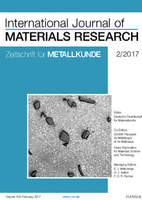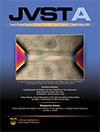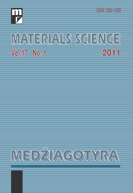
International Journal of Materials Research
Scope & Guideline
Advancing the Frontiers of Materials Science
Introduction
Aims and Scopes
- Materials Characterization:
The journal publishes extensive studies on the physical, chemical, and mechanical properties of materials, utilizing advanced characterization techniques to understand their behavior under various conditions. - Nanomaterials and Nanocomposites:
There is a significant focus on the synthesis, characterization, and application of nanomaterials and nanocomposites, exploring their unique properties for various technological applications. - Biomaterials and Biomedical Applications:
Research on biomaterials, particularly in the context of medical applications such as implants and tissue engineering, is a core area, highlighting the importance of material compatibility and functionality in biological environments. - Sustainable and Green Materials:
The journal promotes research on eco-friendly materials, including those sourced from natural products or designed to minimize environmental impact, aligning with global sustainability goals. - Processing Techniques and Innovations:
The exploration of novel manufacturing and processing techniques, such as additive manufacturing and advanced welding methods, is emphasized to enhance material properties and performance. - Computational Materials Science:
There is a growing interest in computational methods and simulations to predict material behavior and guide experimental designs, showcasing the integration of theoretical research with practical applications. - Surface Engineering and Coatings:
Research on surface modification techniques to enhance the durability, corrosion resistance, and functionality of materials is frequently published, indicating its relevance in materials engineering.
Trending and Emerging
- Advanced Energy Materials:
There is a growing emphasis on materials for energy applications, including batteries, supercapacitors, and solar cells, driven by the global push for sustainable energy solutions. - Smart Materials and Sensors:
Research on smart materials that respond to environmental stimuli and their applications in sensors and actuators is on the rise, reflecting the increasing demand for intelligent systems in various industries. - Additive Manufacturing and 3D Printing:
The journal highlights innovative research in additive manufacturing techniques, showcasing their potential in creating complex geometries and tailored material properties for various applications. - Biodegradable and Eco-Friendly Materials:
There is an increasing trend towards developing biodegradable materials and those derived from renewable resources, aligning with global sustainability efforts and the reduction of plastic waste. - Multifunctional Materials:
Research on multifunctional materials that combine several properties (e.g., electrical, thermal, mechanical) for specialized applications is becoming more prevalent, indicating a shift towards more versatile material solutions. - Machine Learning and AI in Materials Research:
The integration of machine learning and artificial intelligence in materials discovery and characterization is emerging as a significant trend, promising to accelerate the development of new materials through data-driven approaches.
Declining or Waning
- Traditional Metal Alloys:
Research focusing on conventional metal alloys, particularly those without innovative modifications or applications, has decreased, possibly due to the increasing interest in high-performance and multifunctional materials. - Basic Chemical Properties of Materials:
Studies that solely focus on the basic chemical properties of materials without exploring their applications or advanced functionalities have become less common, indicating a shift towards more application-oriented research. - Low-Tech Applications:
There is a noticeable decline in research related to low-tech applications of materials, as the emphasis has shifted towards high-tech and advanced applications that meet contemporary societal needs. - Historical Metallurgy:
Research focused on historical aspects of metallurgy or traditional methods without a modern context is less frequently published, reflecting a preference for contemporary innovations and technologies.
Similar Journals

Advances in Materials Research-An International Journal
Bridging Theory and Application in Materials ResearchAdvances in Materials Research - An International Journal is an esteemed publication in the field of materials science, spearheaded by TECHNO-PRESS. Established to provide a critical platform for the dissemination of high-quality research, this journal focuses on a broad spectrum of topics, including Biomaterials, Ceramics, Composites, Electronic, Optical, Magnetic Materials, Metals, Alloys, and Polymers. With a commendable impact factor reflecting its substantial contribution to the scientific community, Advances in Materials Research promotes innovative ideas through rigorous peer-review processes and supports the continuous advancement of materials research, particularly in the dynamic environment of South Korea. This journal, which holds impressive rankings across various subfields in the Scopus database, is designed to cater to the needs of researchers, professionals, and students aiming to stay at the cutting edge of materials science. By bridging gaps between theory and application, it invites contributions that push the boundaries of knowledge and technology in diverse material applications.

Materials Today Communications
Empowering Global Collaboration in Materials ChemistryMaterials Today Communications, published by ELSEVIER, stands as a prominent platform within the fields of Materials Chemistry, Materials Science, and Mechanics of Materials. With an open access format, this journal facilitates global dissemination of knowledge, aimed at enhancing collaboration and innovation among researchers, professionals, and students worldwide. Established in 2014 and converging through 2024, the journal has rapidly ascended through the ranks, achieving a commendable Q2 category status in multiple relevant categories. Specifically, its Scopus rankings highlight its influence, with rankings in the 64th to 69th percentile in various materials science domains. A key resource for those engaged in cutting-edge materials research, Materials Today Communications provides insightful coverage of contemporary advancements, bridging the gap between theoretical exploration and practical application.

Advanced Materials Interfaces
Transforming Engineering with Interfacial BreakthroughsAdvanced Materials Interfaces is a premier journal dedicated to the exploration and advancement of materials science, with particular emphasis on the interfacial phenomena that govern the behavior of materials in various engineering applications. Published by WILEY in the United Kingdom, this Open Access journal, established in 2014, has quickly ascended to a Q1 category ranking in both Mechanical Engineering and Mechanics of Materials as of 2023, reflecting its significant influence and excellence in the field. With impressive Scopus Ranks, such as #81 out of 672 in Mechanical Engineering and #58 out of 398 in Mechanics of Materials, it serves as a vital resource for researchers and practitioners aiming to push the boundaries of materials innovation. The journal provides unrestricted access to its cutting-edge research, promoting collaboration and dissemination of knowledge among the global scientific community, solidifying its role as a vital contributor to the ever-evolving landscape of materials engineering.

Frontiers in Materials
Unveiling Breakthroughs in Material Technologies.Frontiers in Materials, an esteemed journal published by FRONTIERS MEDIA SA, is a leading platform in the field of Materials Science, with a notable impact factor placing it in the Q2 category of its discipline as of 2023. Since its establishment as an Open Access journal in 2014, it has fostered considerable academic exchange, allowing researchers from around the globe to share their innovative findings and insights. Based in Lausanne, Switzerland, this journal not only emphasizes high-quality peer-reviewed articles but also prioritizes rapid dissemination of research, as evidenced by its commendable Scopus ranking of #62 out of 196 in Materials Science (miscellaneous). By consistently striving to bridge the gap between academia and practical applications, Frontiers in Materials serves as an invaluable resource for researchers, professionals, and students seeking to delve into cutting-edge advancements and transformative applications in materials science.

JOURNAL OF MATERIALS SCIENCE
Exploring Breakthroughs in Materials ScienceJOURNAL OF MATERIALS SCIENCE, published by SPRINGER, stands as a highly regarded periodical in the field of materials science, delivering impactful research since its inception in 1966. With an impressive Q1 ranking in both Mechanical Engineering and Mechanics of Materials, alongside strong Q2 positions in Ceramics, Composites, and General Materials Science, this journal serves as a pivotal resource for scholars and practitioners alike. It offers insightful contributions that span a diverse range of topics, from emerging materials to advanced applications in engineering. With a robust Scopus ranking reflecting its global influence—ranking 91 out of 672 in Mechanical Engineering and 63 out of 398 in Mechanics of Materials—the JOURNAL OF MATERIALS SCIENCE maintains an essential role in advancing the understanding and innovation within the discipline. Researchers, professionals, and students are encouraged to access this esteemed journal to keep abreast of groundbreaking findings and methodologies that shape the future of materials science.

JOURNAL OF VACUUM SCIENCE & TECHNOLOGY A
Innovating Materials Science through Vacuum Technology.JOURNAL OF VACUUM SCIENCE & TECHNOLOGY A, published by the esteemed American Institute of Physics, is a leading journal in the field of materials science and applied physics, with an ISSN of 0734-2101 and an E-ISSN of 1520-8559. This publication serves as a vital platform for researchers and professionals focused on condensed matter physics, surfaces and interfaces, as well as coatings and films, contributing significantly to our understanding of vacuum technology and its applications. With a commendable Q2 ranking in key categories such as Condensed Matter Physics and Surfaces and Interfaces, the journal showcases rigorous research that pushes the boundaries of science and technology. The journal is particularly noted for its impact within the community, holding impressive Scopus rankings that highlight its relevance and influence. Although not an Open Access journal, it remains a crucial resource for academics seeking high-quality, peer-reviewed articles from 1970 through 2024. We invite you to explore the latest advancements and innovative findings that this journal presents, positioning you at the forefront of research in vacuum science.

MRS Advances
Charting New Territories in Physics and EngineeringMRS Advances, published by Springer Heidelberg, is an esteemed academic journal that serves as a vital platform for disseminating cutting-edge research in the fields of condensed matter physics, materials science, and mechanical engineering. With an ISSN of 2731-5894 and an E-ISSN of 2059-8521, the journal is hosted in Switzerland and encompasses an impressive spectrum of innovative studies that impact both theoretical and practical applications. Throughout its converged years from 2012 and continuing through 2024, MRS Advances has established itself with notable rankings, including Q4 in condensed matter physics and Q3 in several related categories. This journal not only enriches the academic community with its rigorous peer-reviewed articles, but also encourages open discussions that further advance research innovations. Although currently not designated as an open-access journal, its accessibility through institutional subscriptions ensures that professionals, researchers, and students can engage with the latest advancements in the material science arena. Emphasizing its relevance, MRS Advances is dedicated to fostering interdisciplinary collaboration and inspiring new discoveries within the global research community.

Accounts of Materials Research
Pioneering solutions for tomorrow's materials challenges.Accounts of Materials Research is a premier journal published by the American Chemical Society, focusing on the multidimensional field of materials science. With a robust impact factor and a commitment to open-access research, it serves as a vital platform for leading-edge discoveries from 2020 to 2024. The journal has rapidly ascended to the top quartile in multiple categories, including Chemical Engineering, Materials Chemistry, and Polymers and Plastics, demonstrating its significant influence within the academic community. Recognized by Scopus as a key resource—with remarkable rankings that place it in the 95th percentile of its field—Accounts of Materials Research is devoted to publishing high-quality, innovative research that addresses critical challenges in materials development and implementation. This journal is essential for researchers, professionals, and students seeking to stay informed about the latest advancements and collaborative opportunities within the interdisciplinary landscape of materials science.

ACS Materials Letters
Empowering Research in Materials and Biomedical EngineeringACS Materials Letters is an esteemed peer-reviewed journal published by the American Chemical Society, emphasizing groundbreaking research and advancements in the fields of materials science, biomedical engineering, and chemical engineering. With a robust update and established reputation since its inception in 2019, this journal has rapidly ascended to the top tiers, achieving Q1 rankings in key categories such as Biomedical Engineering, Chemical Engineering (miscellaneous), and Materials Science (miscellaneous) in 2023. The journal boasts impressive Scopus rankings, including #14 in General Chemical Engineering and #19 in Biomedical Engineering, placing it among the elite publications in these domains. While not fully open access, ACS Materials Letters facilitates the dissemination of high-impact research accessible to academics and industry professionals alike. With its comprehensive scope and rigorous selection process, the journal serves as a vital resource for researchers and students eager to stay abreast of the latest innovations and technologies shaping materials science and engineering.

Materials Science-Medziagotyra
Innovating Tomorrow's Materials TodayMaterials Science-Medziagotyra is a prominent peer-reviewed journal dedicated to the field of materials science, published by Kaunas University of Technology in Lithuania. Since its transition to an Open Access model in 2012, it has facilitated broad dissemination of research findings, enhancing accessibility for researchers and professionals worldwide. This journal is indexed in Scopus and has consistently contributed to the academic community with a focus on innovative materials and their applications, ranking in the Q3 category of Materials Science (miscellaneous) as of 2023. With the responsibility of synthesizing substantial research from 2008 through 2024, Materials Science-Medziagotyra aims to bridge gaps in material research while fostering collaboration among scientists, students, and industry leaders. Its commitment to quality and rigor in scientific discourse underscores its relevance and importance in advancing the field.